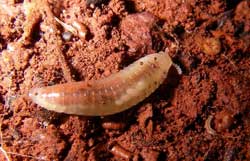Discovery of a translucent ancient millipede in a threatened iron-ore cave in Brazil

Ancient cave millipede (Glomeridesmus spelaeus). Remark the red iron-ore cave substrate.<br><br>University of Lavras (UFLA) in Minas Gerais, Brazil<br>
The curator of millipedes at the Zoological Research Museum Alexander Koenig (ZFMK) in Bonn, Germany was quite surprised when he received an e-mail from Brazil with photographs of a very unusual animal.
The researchers of the work-group 'Subterranean Ecology and Zoology' at the University of Lavras (UFLA) in Minas Gerais, Brazil, Dr. Rodrigo Lopes Ferreira and his student Luiz Felipe Moretti Iniesta, took pictures of strange millipedes in Brazilian caves that they could not identify.
The photographs showed white, translucent millipedes (see picture 1) of a very rare, basal millipede group (Glomeridesmida) which is only known from a few species, none of which were recorded from Brazil.
The Glomeridesmida, which might be around since 350–400 million years ago, belong to the oldest animals living on land and to the most ancient and basal (often called 'primitive') millipedes. Now, they are only known from 31 species, living relics; and even these are only from a few spots of habitat spread out in widely separated areas in Central America, the Caribbean and other islands, India, Malaysia and Indonesia. The last description of a new species of the Glomeridesmida was in 1975. The species of the group are so rarely encountered that the received photographs were the first pictures of living specimens.
Luckily, the Brazilian cave researches studied and conserved some of the glassy-looking animals, and quickly dispatched a few millipedes to the Research Museum Koenig in Germany. There, it was soon discovered that they represent a new, still undescribed, and for the order Glomeridesmida with 10 mm quite large, species. The description, thanks to the help of a modern scanning electron microscope, includes detailed pictures of even the smallest objects. The calcareous exoskeleton and 'armor' of the millipede is so far reduced, that the animal is transparent, an adaptation to the absence of predators in the cave habitat. The millipede’s transparency allows the study of internal anatomy, including the intestine and the eggs, for the first time in these ancient millipede group. Unfortunately, it also makes the animals very soft-shelled and brittle; they break at even soft touches. The newly discovered species is a true troglobiont, it is only found in caves, and more precisely, it is restricted to a special cave system in Brazil.
The caves in which this species thrives were originally below the lush Amazonian rainforest. However, the rainforest has been cleared by humans, so the surface above the cave system is now farmland. Now, even the species sheltered in the subterranean cave system are in danger. Until 2008 all caves were protected by Brazilian law. Since then, caves can be destroyed for mining activities when they do not shelter any animal species that only live in the cave (so-called cave endemics). Such a mining project is currently going on in close vicinity to the cave habitat of the newly described millipede. The cave which the species inhabit is not a normal cave, but a special 'iron ore cave'. Following GoogleEarth satellite images (see KMZ file) one can easily see that the surface has been greatly modified between 2006 (when the caves where still protected) and 2012
https://maps.google.de/maps/ms?msid=202341165093589879967.0004ce87af0fd49db3c6b&msa=0&ll=-5.958882,-49.632368&spn=0.035683,0.038581
Given the circumstances,, the newly discovered cave millipede species was described as quickly as possible, so that the cave system it inhabits can be protected from the ongoing mining activities. Because the mining activities are progressing so fast, it can be concluded that the description of the randomly discovered unique ancient cave millipede appeared just in time, – five years from now the cave system and its unique inhabitants would have been extinct and gone.
The millipedes sent by the Brazilian team not only have the potential to save their species, but, thanks to the freshly collected material, the DNA of the Glomeridesmida can be studied in the future, which allows a genetic study of this ancient millipede order to proceed. In the meantime, additional Brazilian cave millipede species still await their description.
Link to the map of the area where the caves are located. Mining area unaffected in 2006 is marked in red:
https://maps.google.de/maps/ms?msid=202341165093589879967.0004ce87af0fd49db3c6b&msa=0&ll=-5.958882,-49.632368&spn=0.035683,0.038581
Link to the original publication: http://www.mapress.com/zootaxa/2012/f/z03550p042f.pdf
contact: Dr. Thomas Wesener
Curator
Tel.: +49 (0)228 9122 425
Fax: +49 (0)228 9122 212
E-Mail: T.wesener@zfmk.de
Media Contact
More Information:
http://www.mapress.com/zootaxa/2012/f/z03550p042f.pdfAll latest news from the category: Earth Sciences
Earth Sciences (also referred to as Geosciences), which deals with basic issues surrounding our planet, plays a vital role in the area of energy and raw materials supply.
Earth Sciences comprises subjects such as geology, geography, geological informatics, paleontology, mineralogy, petrography, crystallography, geophysics, geodesy, glaciology, cartography, photogrammetry, meteorology and seismology, early-warning systems, earthquake research and polar research.
Newest articles

Innovative 3D printed scaffolds offer new hope for bone healing
Researchers at the Institute for Bioengineering of Catalonia have developed novel 3D printed PLA-CaP scaffolds that promote blood vessel formation, ensuring better healing and regeneration of bone tissue. Bone is…

The surprising role of gut infection in Alzheimer’s disease
ASU- and Banner Alzheimer’s Institute-led study implicates link between a common virus and the disease, which travels from the gut to the brain and may be a target for antiviral…

Molecular gardening: New enzymes discovered for protein modification pruning
How deubiquitinases USP53 and USP54 cleave long polyubiquitin chains and how the former is linked to liver disease in children. Deubiquitinases (DUBs) are enzymes used by cells to trim protein…



